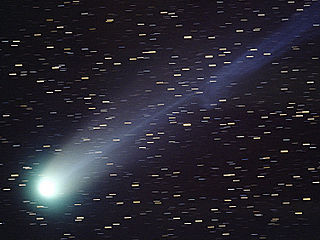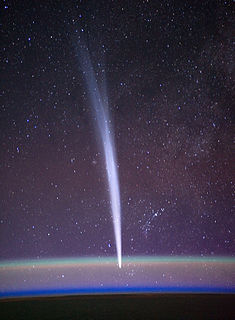Related Research Articles

Comet Hyakutake is a comet, discovered on 31 January 1996, that passed very close to Earth in March of that year. It was dubbed The Great Comet of 1996; its passage near the Earth was one of the closest cometary approaches of the previous 200 years. Hyakutake appeared very bright in the night sky and was widely seen around the world. The comet temporarily upstaged the much anticipated Comet Hale–Bopp, which was approaching the inner Solar System at the time.

The Great January Comet of 1910, formally designated C/1910 A1 and often referred to as the Daylight Comet, was a comet which appeared in January 1910. It was already visible to the naked eye when it was first noticed, and many people independently "discovered" the comet. At its brightest, it outshone the planet Venus, and was possibly the brightest comet of the 20th century.

Comet Arend–Roland was discovered on November 8, 1956, by Belgian astronomers Sylvain Arend and Georges Roland on photographic plates. As the eighth comet found in 1956, it was named Arend–Roland 1956h after its discoverers. Because it was the third comet to pass through perihelion during 1957, it was then renamed 1957 III. Finally, it received the standard IAU designation C/1956 R1 (Arend–Roland), with the "C/" indicating that it was a non-periodic comet and the "R1" showing that it was the first comet reported as discovered in the half-month designated by "R". The last is equivalent to the period September 1–15.
The Eclipse Comet of 1948, formally known as C/1948 V1, was an especially bright comet discovered during a solar eclipse on November 1, 1948. Although there have been several comets that have been seen during solar eclipses, the Eclipse Comet of 1948 is perhaps the best-known; it was however, best viewed only from the Southern Hemisphere.

Comet Pojmański is a non-periodic comet discovered by Grzegorz Pojmański on January 2, 2006 and formally designated C/2006 A1. Pojmański discovered the comet at Warsaw University Astronomic Observatory using the Las Campanas Observatory in Chile as part of the All Sky Automated Survey (ASAS). Kazimieras Cernis at the Institute of Theoretical Physics and Astronomy at Vilnius, Lithuania, located it the same night and before the announcement of Pojmański's discovery, in ultraviolet images taken a few days earlier by the SWAN instrument aboard the SOHO satellite. A pre-discovery picture was later found from December 29, 2005.

C/2001 Q4 (NEAT) is a comet with an unusual, almost perpendicular retrograde orbit which brings it into the inner solar system by a deeply southward path. It initially emerged from its remote home spending most of its time near the south celestial pole. This comet was discovered on August 24, 2001 by the Near-Earth Asteroid Tracking program (NEAT).
Comet C/2006 M4 (SWAN) is a non-periodic comet discovered in late June 2006 by Robert D. Matson of Irvine, California and Michael Mattiazzo of Adelaide, South Australia in publicly available images of the Solar and Heliospheric Observatory (SOHO). These images were captured by the Solar Wind ANisotropies (SWAN) Lyman-alpha all-sky camera on board the SOHO. The comet was officially announced after a ground-based confirmation by Robert McNaught on July 12.

Comet McNaught, also known as the Great Comet of 2007 and given the designation C/2006 P1, is a non-periodic comet discovered on 7 August 2006 by British-Australian astronomer Robert H. McNaught using the Uppsala Southern Schmidt Telescope. It was the brightest comet in over 40 years, and was easily visible to the naked eye for observers in the Southern Hemisphere in January and February 2007.

Comet Lulin is a non-periodic comet. It was discovered by Ye Quanzhi and Lin Chi-Sheng from Lulin Observatory. It peaked in brightness and arrived at perigee for observers on Earth on February 24, 2009, at magnitude +5, and at 0.411 AU from Earth. The comet was near conjunction with Saturn on February 23, and outward first headed towards its aphelion, against the present position of background stars, in the direction of Regulus in the constellation of Leo, as noted on February 26 and 27, 2009. It was expected to pass near Comet Cardinal on May 12, 2009. The comet became visible to the naked eye from dark-sky sites around February 7. It figured near the double star Zubenelgenubi on February 6, near Spica on February 15 and 16, near Gamma Virginis on February 19 and near the star cluster M44 on March 5 and 6. It also figured near the planetary nebula NGC 2392 on March 14, and near the double star Wasat around March 17. According to NASA, Comet Lulin's green color comes from a combination of gases that make up its local atmosphere, primarily diatomic carbon, which appears as a green glow when illuminated by sunlight in the vacuum of space. When SWIFT observed comet Lulin on 28 January 2009, the comet was shedding nearly 800 US gallons (3,000 l) of water each second. Comet Lulin was methanol-rich.

Comet C/2010 X1 (Elenin) is an Oort cloud comet discovered by Russian amateur astronomer Leonid Elenin on December 10, 2010, through remote control of the International Scientific Optical Network's robotic observatory near Mayhill in the U.S. state of New Mexico. The discovery was made using the automated asteroids discovery program CoLiTec. At the time of discovery, the comet had an apparent magnitude of 19.5, making it about 150,000 times fainter than can be seen with the naked eye. The discoverer, Leonid Elenin, originally estimated that the comet nucleus was 3–4 km in diameter, but more recent estimates place the pre-breakup size of the comet at 2 km. Comet Elenin started disintegrating in August 2011, and as of mid-October 2011 was not visible even using large ground-based telescopes.
C/2001 OG108 (LONEOS) is a Halley-type comet with an orbital period of 48.51 years. It was discovered on 28 July 2001 by the LONEOS telescope at Lowell Observatory. Of the short-period comets with known diameters and perihelion inside the orbit of Earth, C/2001 OG108 is the second largest after Comet Swift–Tuttle.

C/2011 L4 (PANSTARRS) is a non-periodic comet discovered in June 2011 that became visible to the naked eye when it was near perihelion in March 2013. It was discovered using the Pan-STARRS telescope located near the summit of Haleakalā, on the island of Maui in Hawaii. Comet C/2011 L4 probably took millions of years to come from the Oort cloud. After leaving the planetary region of the Solar System, the post-perihelion orbital period is estimated to be roughly 106000 years. Dust and gas production suggests the comet nucleus is roughly 1 kilometer (0.62 mi) in diameter.

Comet Lovejoy, formally designated C/2011 W3 (Lovejoy), is a long-period comet and Kreutz sungrazer. It was discovered in November 2011 by Australian amateur astronomer Terry Lovejoy. The comet's perihelion took it through the Sun's corona on 16 December 2011, after which it emerged intact, though greatly impacted by the event.

Comet ISON, formally known as C/2012 S1, was a sungrazing comet discovered on 21 September 2012 by Vitaly Nevsky and Artyom Novichonok.

C/2012 F6 (Lemmon) is a long-period comet discovered in Leo on 23 March 2012, by A. R. Gibbs using the 1.5-m reflector at the Mt. Lemmon Survey, located at the summit of Mount Lemmon in the Santa Catalina Mountains north of Tucson, Arizona, USA. Initially, the object was considered to be of asteroidal nature before later observations confirmed its cometary appearance. Comet Lemmon has a highly eccentric orbit, bringing it as close to 0.73 AU from the sun at perihelion and as far as 973 AU from the sun at aphelion. This also leads to the comet's long-period nature with an orbital period of approximately 8,000 years based on epoch 2050. The comet last reached perihelion on 24 March 2013.

C/2012 K1 (PANSTARRS) is a retrograde Oort cloud comet discovered at magnitude 19.7, 8.7 AU from the Sun on 17 May 2012 using the Pan-STARRS telescope located near the summit of Haleakalā, on the island of Maui in Hawaii (U.S.).

C/2013 R1 (Lovejoy) is a long-period comet discovered on 7 September 2013 by Terry Lovejoy using a 0.2-meter (8 in) Schmidt–Cassegrain telescope. It is the fourth comet discovered by Terry Lovejoy. C/2013 R1 crossed the celestial equator on 14 October 2013, becoming a better Northern Hemisphere object.
C/2013 V5 (Oukaimeden) is a retrograde Oort cloud comet discovered on 12 November 2013 by Oukaimeden Observatory at an apparent magnitude of 19.4 using a 0.5-meter (20 in) reflecting telescope.

C/2014 Q2 (Lovejoy) is a long-period comet discovered on 17 August 2014 by Terry Lovejoy using a 0.2-meter (8 in) Schmidt–Cassegrain telescope. It was discovered at apparent magnitude 15 in the southern constellation of Puppis. It is the fifth comet discovered by Terry Lovejoy. Its blue-green glow is the result of organic molecules and water released by the comet fluorescing under the intense UV and optical light of the Sun as it passes through space.

C/2013 US10 (Catalina) is an Oort cloud comet discovered on 31 October 2013 by the Catalina Sky Survey at an apparent magnitude of 19 using a 0.68-meter (27 in) Schmidt–Cassegrain telescope. As of September 2015 the comet is around apparent magnitude 6.
References
- 1 2 "JPL Small-Body Database Browser: C/2007 F1 (LONEOS)" (2007-10-28 last obs). Jet Propulsion Laboratory . Retrieved 2011-03-13.
- ↑ Horizons output. "Barycentric Osculating Orbital Elements for Comet C/2007 F1 (LONEOS)" . Retrieved 2011-03-12. (Solution using the Solar System Barycenter and barycentric coordinates. Select Ephemeris Type:Elements and Center:@0)
- ↑ Kracht, Rainer. "Comets in SECCHI Images".

